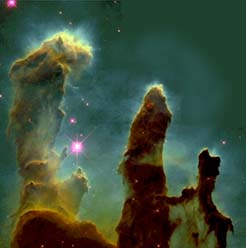Examples of H II Regions
|
The glowing H II regions are called emission nebulae. Some of the most famous (from Kaufmann, Ch 20) are:
|
 |
Star concepts
Reference
Kaufmann
| HyperPhysics***** Astrophysics | R Nave |
Examples of H II Regions
|
Index Star concepts Reference Kaufmann | ||||||||||||||||||||
|
Go Back |
H II RegionsAreas in space which are luminous with the emission spectrum of ionized hydrogen are called H II regions. They are associated with the presence of massive O-type and B-type stars. Such stars, having surface temperatures in the range 15,000 - 30,000K, have characteristic blackbody radiation curves which peak in the ultraviolet. These stars will often be surrounded by vast clouds of hydrogen gas, and the uv can ionize the hydrogen atoms. These hydrogen atoms tend to attract electrons and reassemble, with the captured electrons cascading down through the quantum states of the hydrogen atom, emitting characteristic photons of light upon each downward jump. A characteristic visible color from such emission is red light at 656 nm associated with the n=3 to n=2 transition which is called H-alpha. Depending upon the recession velocity of the nebula, the light will be red-shifted, but many regions like the M16 region show a red glow characteristic of the hydrogen emissions. H II regions are associated with young star clusters, and are useful as a part of astronomical distance measurement.
|
Index Star concepts | ||
|
Go Back |